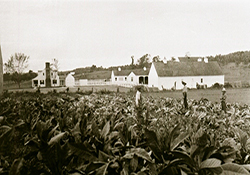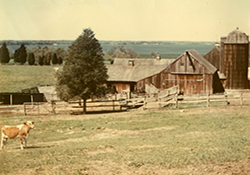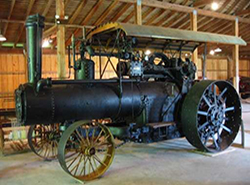Point Farm
 While looking for a farm to buy, Mr. Patterson saw the property known as Peterson Point during a 1932 flyover of Southern Maryland. He really liked the location and the abundance of fields and pastures. He immediately contacted the owners and purchased it, renaming the property Point Farm. When asked why he chose this farm, he said the vast stretches of water drew him and "I fancied the rich and varied vegetation of the county where the trees and shrubs of North and South grow in harmony and beauty, and where the growing season is so long that even the winter … seems a restful interlude."
While looking for a farm to buy, Mr. Patterson saw the property known as Peterson Point during a 1932 flyover of Southern Maryland. He really liked the location and the abundance of fields and pastures. He immediately contacted the owners and purchased it, renaming the property Point Farm. When asked why he chose this farm, he said the vast stretches of water drew him and "I fancied the rich and varied vegetation of the county where the trees and shrubs of North and South grow in harmony and beauty, and where the growing season is so long that even the winter … seems a restful interlude."
After purchasing the property, Mr. Patterson immediately searched for an architect as well as someone to manage the property in his absence. Based on recommendations, he hired as his architect, Gertrude Sawyer who worked for Horace Peaslee in Washington, DC. She began immediately to design the farm buildings and Beach Cottage, built in 1932. She also began designs for his home on the site of the old Peterson house which Mr. Patterson had torn down.
Farm Design and Organization
 The center of operations for Point Farm was the “Farm Group” of buildings. Here the farm manager had a two-story home with electricity, plumbing and central heat (which was novel at the time). There was also an attached one-car garage.
The center of operations for Point Farm was the “Farm Group” of buildings. Here the farm manager had a two-story home with electricity, plumbing and central heat (which was novel at the time). There was also an attached one-car garage.
The farm buildings, starting with the manager's house formed a U-shape. Included were a small animal barn, a machine shed and workroom, a barn for dairy cows and horses, and a storage building for grain and hay. Behind the horse and dairy barn was a tobacco barn with stripping room. This building remained from the Peterson Farm and was moved to this location from across the farm road. A well house sat behind the garage and a smokehouse was behind and next to the garage.
The farm manager oversaw daily operations at Point Farm and was Mr. Patterson’s advisor in selecting the Aberdeen Angus bull and cows for the herd. The cattle were a source of pride and enjoyment for Mr. Patterson. Although away on a mission to various countries, he always corresponded with his farm manager to keep track of the prizes his cattle won and to see how the crops were going.
In addition to the Farm Manager, there was a Tenant Farmer. He lived where the Breckinridge Center is now in another house designed by Gertrude Sawyer called Hill Top House. This house had a small barn where Point Farm’s prize bull was stalled in the early days. There was also a chicken house and smoke house. At the foot of the hill to the north was the oldest building on the property, an old tobacco barn with stripping shed. It is still in place with the help of some restoration work.
The steer barn was designed and built in 1933. Many steers and dairy cows were fed and pastured here. This building is now the Pavilion used for events at Jefferson Patterson Park and Museum.
 A show barn for prize bulls was built in 1954. The Farm Manager’s office here held a large display of ribbons won by the bulls and herd. This building is now the Visitor Center for Jefferson Patterson Park and Museum.
A show barn for prize bulls was built in 1954. The Farm Manager’s office here held a large display of ribbons won by the bulls and herd. This building is now the Visitor Center for Jefferson Patterson Park and Museum.
Farmers of the Past
When Mr. Patterson bought Peterson Point, the Fowler family was renting the Peterson House. They were farming the Peterson property. The farm went through a transition period as Mr. Patterson built facilities and hired Mr. John King to provide oversight and guidance for his farm. Mr. Stanley Houghton was eventually hired to be Farm Manager for Point Farm. He worked hard to develop and manage a fine Aberdeen Black Angus herd.
They worked together until Mr. Houghton’s death in 1955. The herd was then sold and the emphasis shifted to raising the traditional income crops – tobacco, corn, wheat, and hay.
Mr. Leroy Beverly was chosen as the new farm manager in 1955 working to raise crops and tend a herd of feeder cattle from produce of the farm and pasturage. The feeder cattle operation ended in 1969 as it proved unprofitable. Mr. Beverly introduced soybeans as a crop for late-season harvest. He worked for Mr. Patterson until the end of 1972.

Operations changed at Point Farm in January 1973 when Mr. Raymond Cullumber began a lease as tenant farmer. This operation continued until Mr. Patterson’s death in November 1977. Mrs. Patterson soon began looking for a way to honor Mr. Patterson through Point Farm. When she gifted the farm to the State of Maryland in 1983, one of the provisions of the gift was the continued cultivation of some of the fields at Point Farm. This practice continues through the rental of certain fields for farming.
 Sample of land use map at Point Farm
Sample of land use map at Point FarmCurrent Farm Activities
The beautiful fields of Point Farm continue to produce crops typical of southern Maryland agriculture. The current farmer is Mr. Buddy Hance.
Another aspect of gardening or growing of crops is performed in the Indian Village demonstration garden developed by our Education and Horticulture departments.
 Exhibits
Exhibits
Currently, the Exhibit barn includes a smaller, representative exhibit of the types of equipment used in the past to plant and harvest crops on Point Farm and other farms in Southern Maryland.
The Farmall tractor from Point farm and the manure spreader behind it are evocative of the hard work it took to get fields ready to plant. In contrast, are the walk- behind pieces of equipment for tilling and planting. There is even a vertical tobacco prize. The most striking equipment example is the Frick steam traction engine. It looks like a locomotive engine. These were used in some areas around here, but probably more in the Midwest.